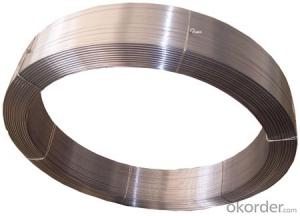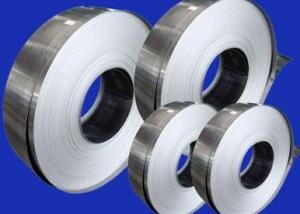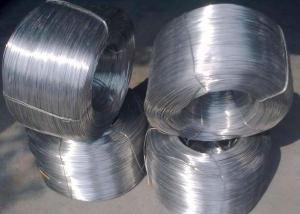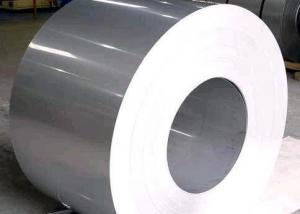Submerged Arc steel Welding Wires EM12K
- Loading Port:
- Qingdao
- Payment Terms:
- TT OR LC
- Min Order Qty:
- 10 m.t.
- Supply Capability:
- 1000 m.t./month
OKorder Service Pledge
OKorder Financial Service
You Might Also Like
Specifications
The submerged arc welding wire series products feature excellent welding and mechanical performances.
Submerged Arc Welding Wire
The products easily removable residue, good seam forming and highly efficient deposiyion.Wire meltingdoes not lead to splash or strong flasing.The sem surface is smooth and welding quality is guaranteed. They facilitate mechanical and automatic welding process. With a wide range of welding parameters, the wires can be used in open fields with strong wind and applied to automobiles, ships, bridges and chemical engineering.
Main Applications:
Applicable to welding of low-carbon steel and some low-alloy steel(such as 16Mn); automatic
submerged arc welding of boilers, pressure vessels, etc.
Chemical compositions of one sample wire(%)
C 0.06 Mn 0.94 Si 0.024 Cr 0.025 Ni 0.015 Cu 0.130 S 0.014 P 0.017
Mechanical Properties of one sample deposited metal
Yield Strength(Mpa) 469
Tensile Stregth(Mpa) 578
Elongation(%) 28
Impact Energy(-20°c) (J) 87
- Q:How long does stainless steel wire last?
- Stainless steel wire boasts exceptional durability and resistance to corrosion, rendering it an extremely dependable option for various uses. The lifespan of stainless steel wire can differ based on factors like the surroundings it is exposed to, the caliber of the stainless steel employed, and the level of upkeep it receives. Nevertheless, on average, stainless steel wire can endure for multiple decades, if not longer. In non-corrosive or indoor environments, stainless steel wire can remain intact indefinitely without displaying any indications of deterioration. In more aggressive settings, such as marine or industrial environments, the lifespan of stainless steel wire may be diminished, but it still surpasses other materials. Regular cleaning and maintenance can substantially extend the lifespan of stainless steel wire and guarantee its continuous functionality and aesthetic appeal. All in all, stainless steel wire is renowned for its remarkable longevity, making it a cost-efficient choice for a broad array of applications.
- Q:Is stainless steel wire easy to solder?
- Soldering stainless steel wire is not a simple task. Unlike metals like copper or brass, stainless steel possesses high heat resistance and oxidation resistance, posing challenges in creating a sturdy and dependable solder connection. Moreover, stainless steel is frequently coated or treated with a thin layer of chromium oxide, further impeding the soldering procedure. To achieve success in soldering stainless steel wire, specialized fluxes and high-temperature soldering techniques are necessary. It is worth mentioning that soldering may not always be the optimal choice for stainless steel, and alternative approaches like welding or mechanical fastening may be more appropriate.
- Q:Is stainless steel wire easily cut?
- Stainless steel wire is known for its high strength and durability, which makes it much more difficult to cut compared to other types of wire. It has a high resistance to corrosion, heat, and impact, making it an ideal choice for various applications, such as construction, manufacturing, and even in medical devices. However, cutting stainless steel wire can still be accomplished with the right tools and techniques. Specialized tools like wire cutters or cable cutters with hardened blades and high leverage can be used to cut through stainless steel wire effectively. Additionally, using lubricants or applying heat to the wire can also help make the cutting process easier. So, while stainless steel wire is not easily cut by everyday tools, with the right tools and methods, it can be cut efficiently.
- Q:What is the maximum length of stainless steel wire that can be supplied?
- The supply of stainless steel wire is contingent upon several factors, such as the supplier's manufacturing capabilities and resources. Nonetheless, it is common for stainless steel wire to be accessible in lengthy, uninterrupted strands. As a rule, stainless steel wire can be obtained in lengths spanning from a few feet to thousands of feet. Certain suppliers may even offer tailor-made lengths to meet specific demands. To ascertain the maximum length of stainless steel wire that a supplier can provide, it is advisable to directly consult with the supplier or manufacturer.
- Q:Is stainless steel wire suitable for outdoor signage?
- Yes, stainless steel wire is suitable for outdoor signage. It is highly resistant to corrosion, weather conditions, and UV rays, making it a durable and long-lasting option for outdoor use. Additionally, stainless steel wire provides a sleek and professional appearance, making it an ideal choice for signage in various outdoor settings.
- Q:What is the difference between stainless steel plate, matte surface and wire drawing surface?
- Stainless steel surface processing, matte and wire drawing are the same concept. What difference would you like to ask between different wire drawing?. Now the surface processing are generally straight wire and floss (Xue Hua), the Silk Road thickness can be adjusted, and different processing machine plate silk road will be different
- Q:Can stainless steel wire withstand high temperatures?
- Yes, stainless steel wire can withstand high temperatures.
- Q:What are the common uses of stainless steel wire in the water treatment industry?
- Various purposes in the water treatment industry rely heavily on the utilization of stainless steel wire. A popular application involves the construction of filtration systems, where stainless steel wire mesh screens are commonly employed to separate solid particles from water during the filtration process. The exceptional corrosion resistance of stainless steel ensures that the wire remains intact when exposed to water or chemicals, making it the perfect choice for long-term usage in water treatment facilities. Another significant role of stainless steel wire in the water treatment industry lies in the production of filter cartridges. These cartridges serve the purpose of eliminating impurities and contaminants from water. The flexibility and strength of stainless steel wire facilitate the creation of durable and efficient filter cartridges that can endure high pressure, maintain their shape, and remain intact over time. Additionally, stainless steel wire is also extensively used in the construction of water treatment equipment such as pumps and valves. These crucial components necessitate materials capable of withstanding the harsh conditions experienced during water treatment processes, including exposure to chemicals, high temperatures, and pressure. Stainless steel wire offers the requisite strength, corrosion resistance, and durability required for these applications, ensuring the dependable and efficient operation of water treatment systems. Furthermore, stainless steel wire finds application in the production of screens for intake structures and water intakes. These screens effectively prevent unwanted materials such as debris and algae from entering water treatment facilities, thereby safeguarding the equipment and preserving the efficacy of the treatment process. Overall, stainless steel wire stands as a versatile and indispensable material in the water treatment industry. Its corrosion resistance, durability, and strength render it suitable for a wide range of applications, encompassing filtration systems, filter cartridges, equipment construction, and intake screens. By harnessing the potential of stainless steel wire, the water treatment industry can guarantee the effective and efficient treatment of water, thereby contributing to the provision of clean and safe water for various purposes.
- Q:Does stainless steel wire have any magnetic properties?
- Yes, stainless steel wire does have magnetic properties. However, the amount of magnetism it exhibits depends on its composition and grade. Some stainless steel alloys are non-magnetic, while others may be slightly magnetic.
- Q:What are the different types of stainless steel wire rope hooks?
- There are several different types of stainless steel wire rope hooks available, each designed for specific applications and requirements. Some of the common types include: 1. Clevis Hook: This is a standard type of hook with a clevis pin that can be easily attached or detached from the wire rope. It provides a secure connection and is commonly used in lifting and hoisting operations. 2. Eye Hook: This type of hook has a closed loop or eye at the end, which allows for easy attachment of the wire rope. It is often used in applications where the hook needs to be permanently connected to the rope. 3. S-Hook: The S-hook gets its name from its shape, resembling the letter "S". It has a curved end that is used to attach the hook to the wire rope. S-hooks are commonly used in lighter-duty applications such as hanging signs or securing objects. 4. Carabiner Hook: This type of hook is shaped like a carabiner, typically used for climbing or rigging purposes. It features a spring-loaded gate that can be easily opened and closed for quick attachment or detachment of the wire rope. 5. Snap Hook: Snap hooks are similar to carabiner hooks but typically have a wider, flat shape with a spring-loaded gate. They are commonly used in applications where quick attachment and detachment are required, such as in marine or construction industries. 6. Swivel Hook: A swivel hook features a rotating mechanism that allows the hook to rotate freely, preventing twisting or kinking of the wire rope. It is commonly used in lifting operations where the load may rotate or spin. It is important to select the appropriate type of stainless steel wire rope hook based on the specific application, load capacity, and environmental conditions to ensure safe and efficient operations.
1. Manufacturer Overview |
|
|---|---|
| Location | |
| Year Established | |
| Annual Output Value | |
| Main Markets | |
| Company Certifications | |
2. Manufacturer Certificates |
|
|---|---|
| a) Certification Name | |
| Range | |
| Reference | |
| Validity Period | |
3. Manufacturer Capability |
|
|---|---|
| a)Trade Capacity | |
| Nearest Port | |
| Export Percentage | |
| No.of Employees in Trade Department | |
| Language Spoken: | |
| b)Factory Information | |
| Factory Size: | |
| No. of Production Lines | |
| Contract Manufacturing | |
| Product Price Range | |
Send your message to us
Submerged Arc steel Welding Wires EM12K
- Loading Port:
- Qingdao
- Payment Terms:
- TT OR LC
- Min Order Qty:
- 10 m.t.
- Supply Capability:
- 1000 m.t./month
OKorder Service Pledge
OKorder Financial Service
Similar products
New products
Hot products
Related keywords


























